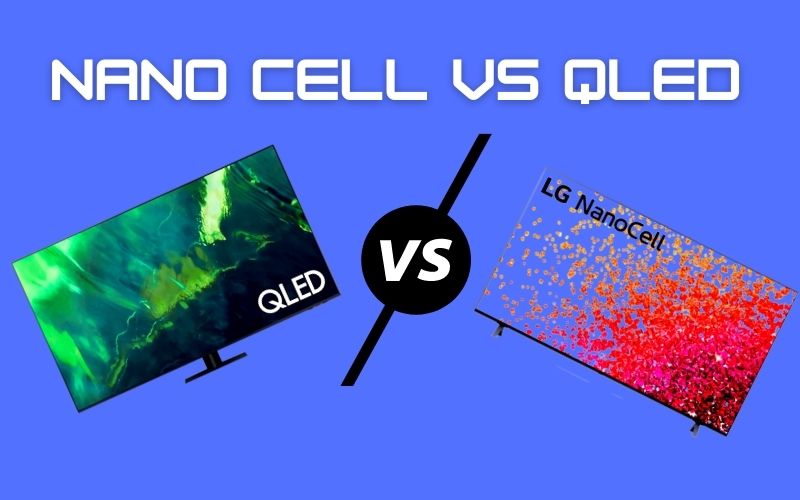LG Nano cell vs. Samsung Q-LED is high-end TV series. The versatility in features that you can obtain from these models seems unparalleled. For instance; HDR, VA and IPS Panels, Ultra HD 4k TV resolution, HDMI, and whatnot. Well, in a direct comparison of Nano cell vs QLED, the basic concept is essential to be explained first.
In a more general perspective, LG Nano Cell with its 4k resolution and wide viewing angle allowing multi-pairing for gaming more conveniently is better than Q-LED. But based on your intended use and requirements, both Q-LED and Nano-cell have their benefits and flaws.
We are going to have a look at the foundational differences between both models. And then decide which one is good or better for what specific reasons and needs. This post will help you choose the model more suitable for your needs and demand.
Check our buying guide on the best TVs for bright rooms that include LG Nano and Samsung Q-Led.

Basics of Nano Cell vs QLEDs
Samsung and LG, both designed their displays on the typical principle of LCD TV. But the enhancement technique of LG resulted in Nano Cell display technology and that of Samsung in QLED. Ever since the Nano cell vs QLED debated ensued. So let’s undertand the basics first.
Q-LED
QLED is a specific enhancement tactic applied by Samsung in its model series stands for quantum dot LED TV. It is abbreviation of Quantum dots are layered behind the LCD panel. These dots are microscopic crystal-like cells that emit and transmit their distinct light in red, green, and blue color on getting hit by any light. The image pixel is thus formed after this, transmitted light; passes a few more layers including the liquid crystal display. So, Q-LED is “transmissive”.
Nano cells
Nano Cells are nano-scale particles that act as a panel in front of an LCD panel. The specific specialty lies in these particles that act as a light-absorbing filter and avoid or remove the unwanted dull shaded color from the image display. Moreover, the transitions become smoother in the case of similar colors.
Technically, both bring life to colors and image display. But, this creates the foundational difference in both, Samsung and LG. In general opinion, quantum dots are not very specific as Vizio and Hisense also offer this without calling it out in their series by name.
Let us compare LG nano cell vs. Q-LED directly under some main features.
If you are interested to buy LG Nano Cell bs QLED by Samsung, you don’t want to miss our review of the best 65-75 TV under $1500.
Comparison of LG Nano Cell & Samsung Q-LED
LG Nano Cell TV uses IPS panels including different initial features. IPL handles reflections or any other light source in the room and displays sufficient brightness. These offer a wider viewing angle but in very dark rooms, a slight gray touch can be observed due to back-lightening. This means blacks are not that smooth, uniform, or deep. An additional feature comes along many nano cell TVs that are high-end screens, they have local dimming in additional full arrays. This increases contrast and makes LG Nano Cell TV a perfect fit for bright rooms.
Samsung Q-Led uses a VA panel, which is vertical alignment. Its contrast and brightness suffice the HDR content. These are very colorful and extremely saturated with blacks, darker than LG nano cell Tv. Because of its limited viewing angle, colors lose a bit of luminosity when seen at an angle. Only then one can sense a grey haze.
LG Nano Cell 4k TV vs. Samsung Q-LED 4k TV
With 4k resolution, the impressive picture quality is assured by both brands. If you don’t care about price and stuff, then LG Nano Cell 4k TV is what you really need. It brings comfort to your leisure time with its HDMI ranging to 2.1 and all the other benefits it comes with. Both of the TVs appear as ideal gaming devices as they support Variable Refresh Rates and up to 4k and 120fps.
The only leverage that makes LG a bit better for gaming is its wide viewing angle, which is perfect for playing with two players. Furthermore, LG Nano-cell TV supports cloud gaming which is not being offered by Samsung.
Key Features that add to the smartness of LG Nano-cell and Samsung Q-LED:
Comparing the LG Nano cell 9 with Samsung q-led 60, you can get the stuff of your interest from these advanced TV devices. LG Nano Cell is offering LG ThinQ AI along with Alexa and Google Assistant. And that’s not an end. It also has an intelligent processor of a7 Gen 2, and do connects to Apple Airplay and Home-kit. This feature is enough to give a push to your home life. Besides, Samsung does not offer such supports. It has a twin tuner for that.
Audio Formats: If you don’t have a soundbar, with Q-LED; it’s not even needed. Both TVs can transmit Dolby Atmos via HDMI eARC. Even DTS is supported by nano cells.
Reflections Effect
Both Q-LED and Nano-cell do not have very convincing experience in very bright rooms. LG can adapt to more brightness comparatively. Which, makes it better in reflection handling.
Viewing Angle Comparison
The viewing angle gets different with the VA panel and more significant with IPS. Nano Cell TV has a wider viewing angle than Samsung holding a limited viewing angle.
Movies, Gaming & Series
Now comes my favorite part. Nano cell vs QLED for gaming and movies which is the main use of TV.
If you love watching series or movies then your TV purchase can depend on what time you fix for watching. Like Samsung, Q-LED can go better in the evening; darker background. While, Nano cell is more preferable for afternoon watch-time.
And for gaming, both Nano cell and Q-LED support gaming at 4k resolution. But in my opinion, Nano cell is better with its 4k resolution and wide viewing angle that eases pair gaming.
Winding up
Both Nano cell vs Qled devices are suitable depending on your need. Once you are clear with what you need on your TV, it makes TV purchases a lot easier. Both Q-LED and Nano-cell have their benefits and flaws.
In a more general perspective, LG Nano Cell with its 4k resolution and wide viewing angle allowing multi-pairing for gaming more conveniently are better than Q-LED. And rest is your choice!

